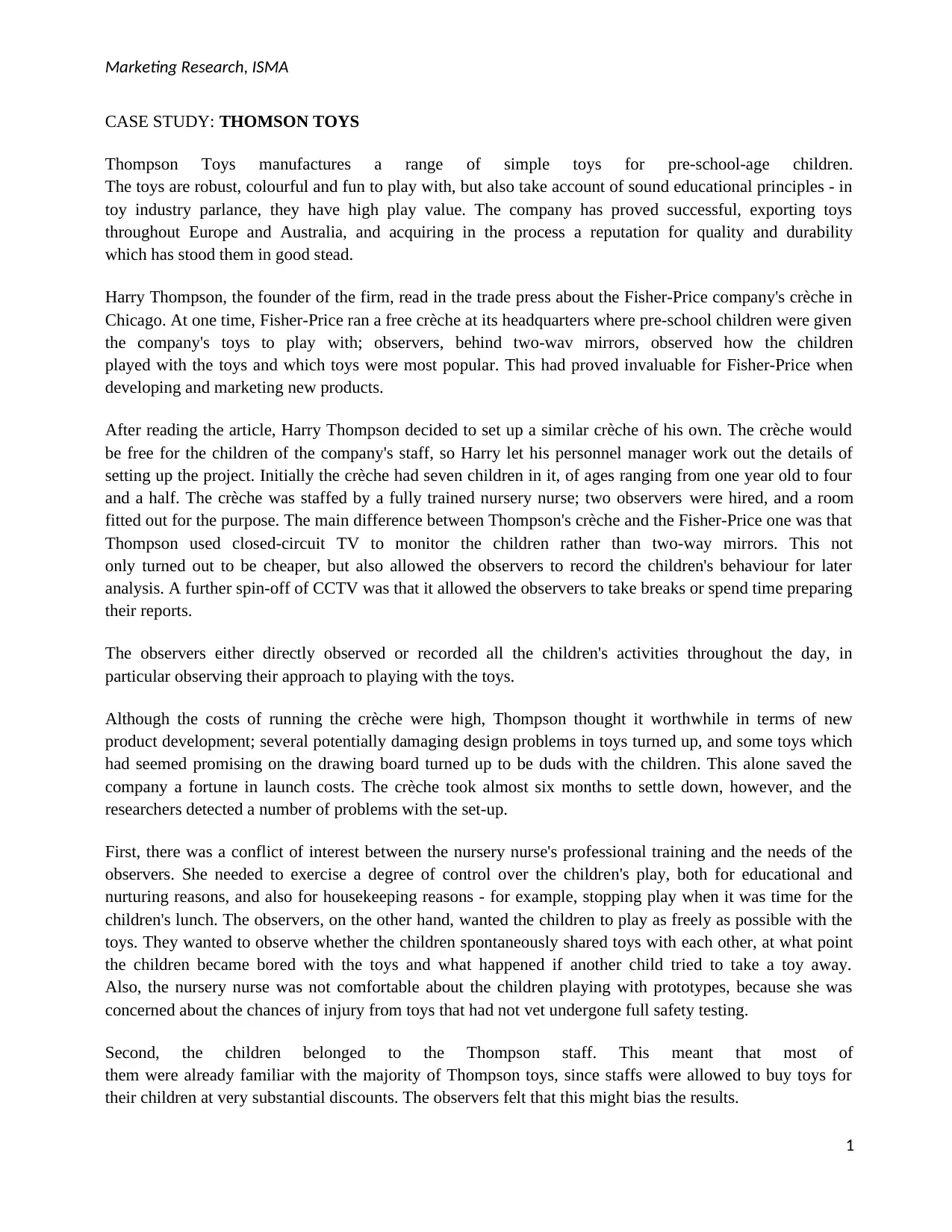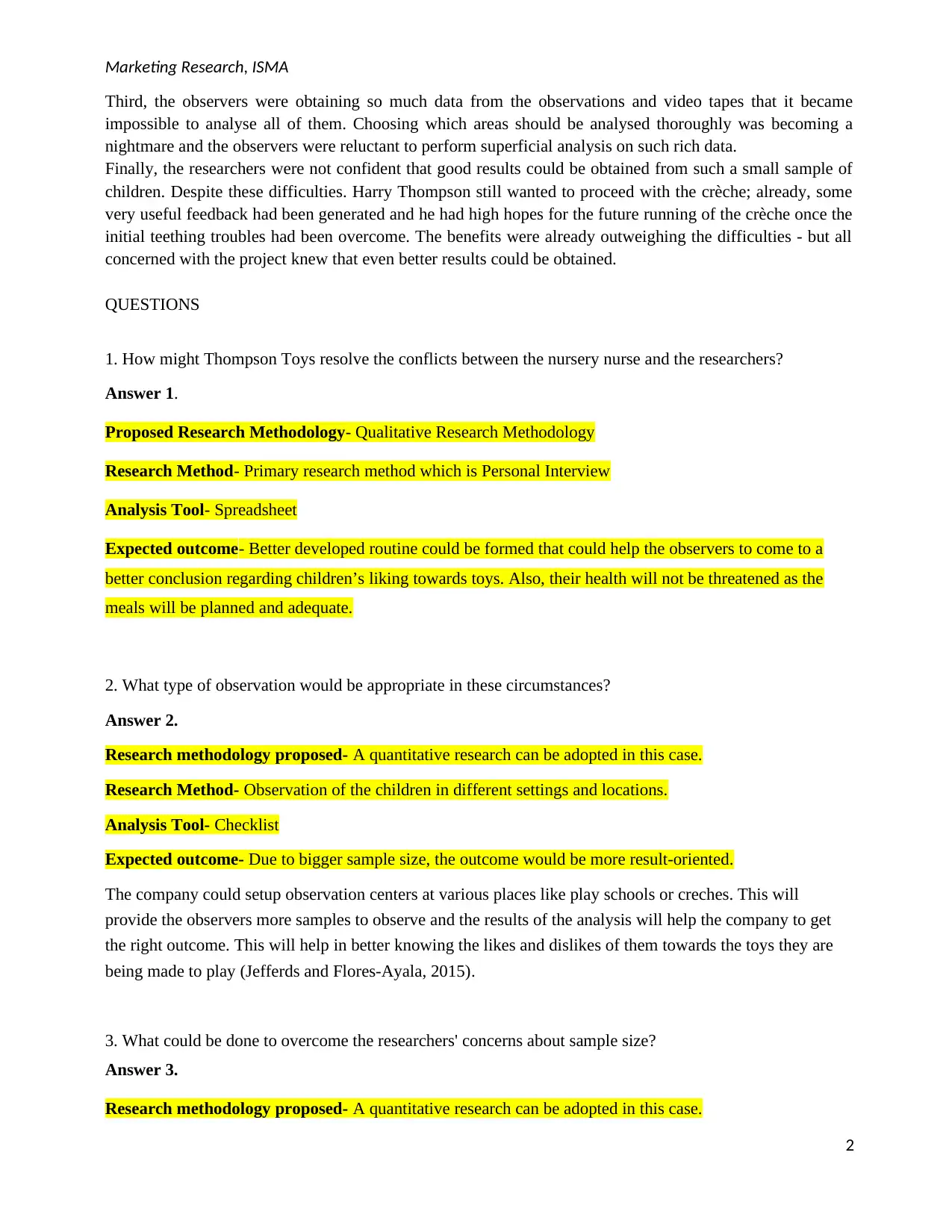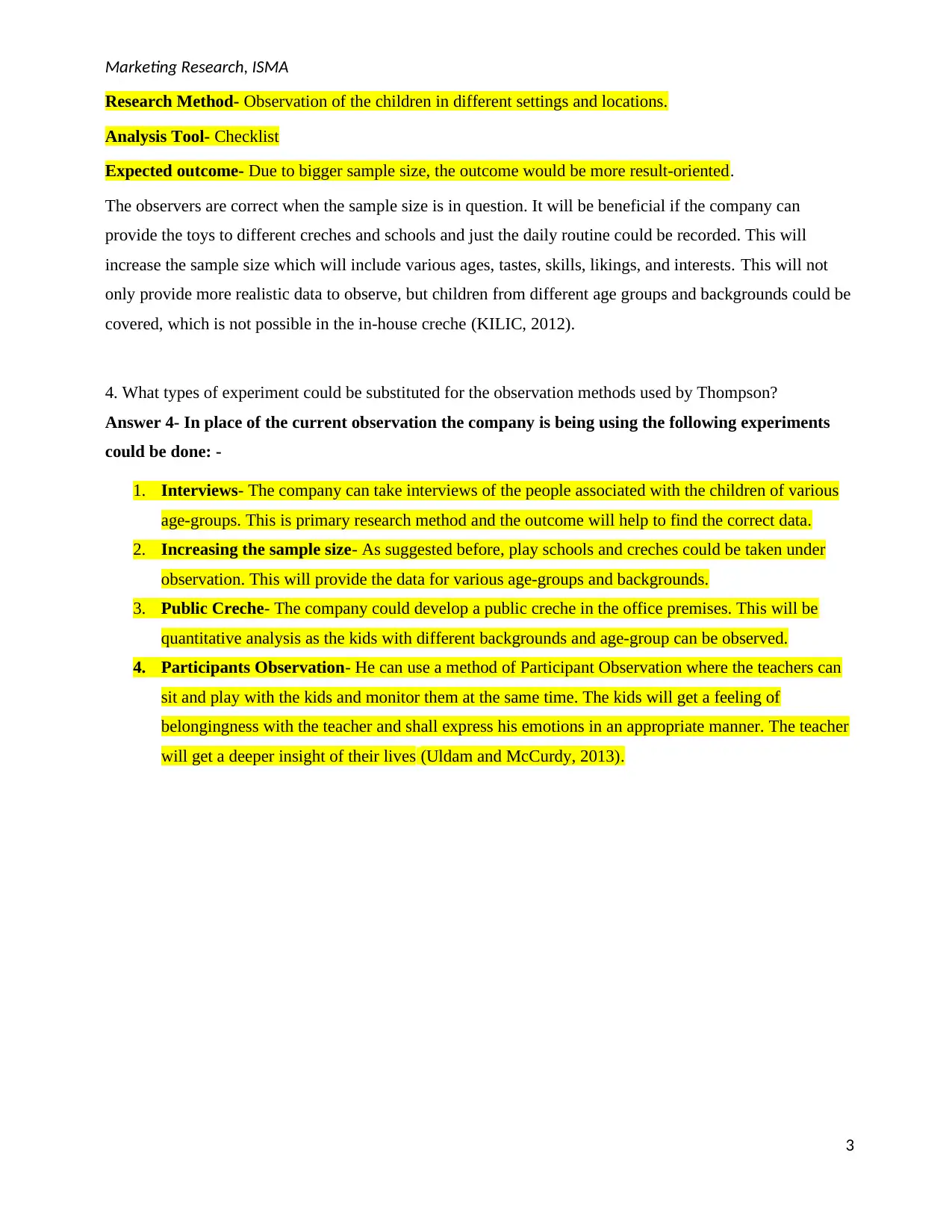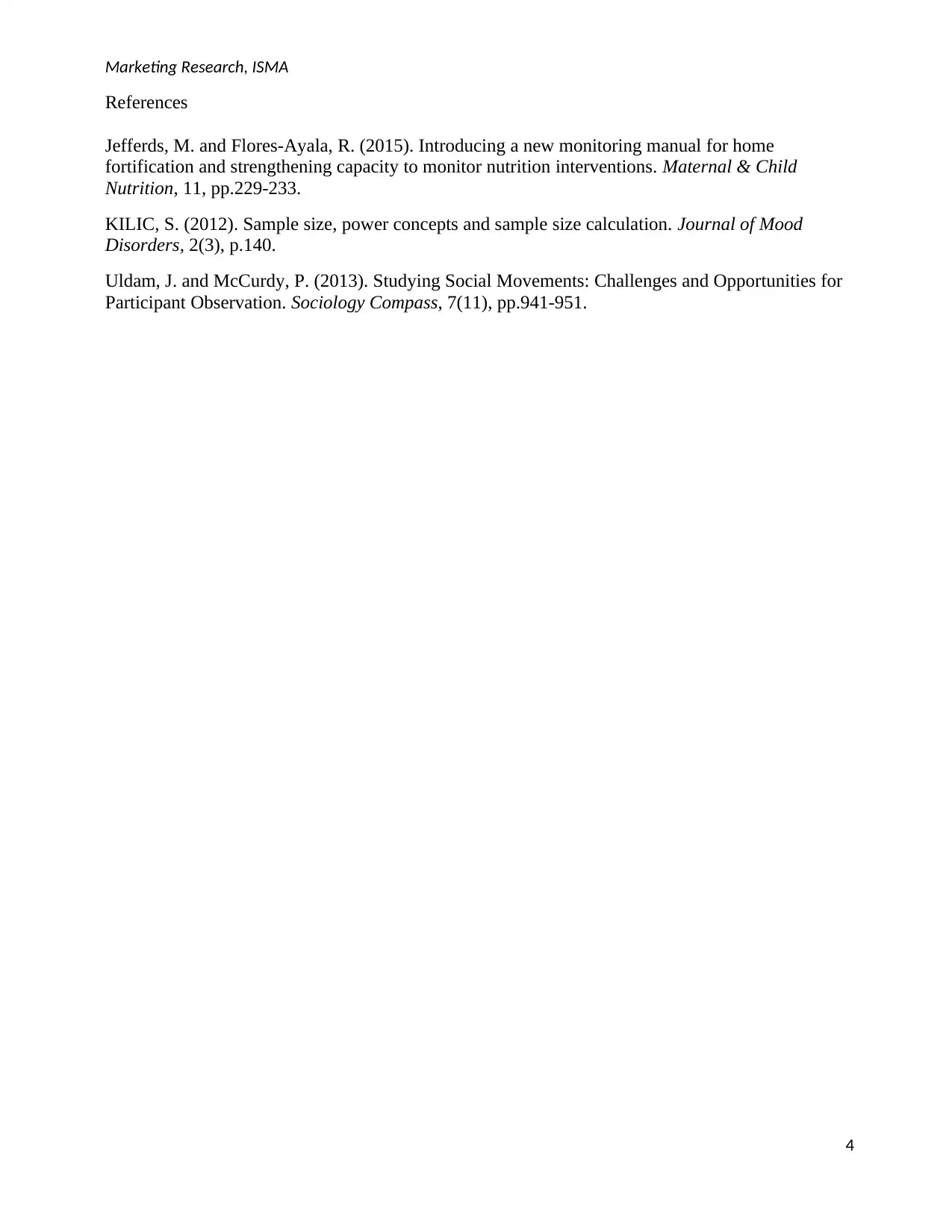Case Study: Thomson Toys - Marketing Research Strategies ISMA
VerifiedAdded on 2023/05/29
|4
|1479
|269
Case Study
AI Summary
This assignment provides solutions to the Thomson Toys case study, which focuses on the company's use of a crèche for observing children's interactions with toys to inform product development. The analysis addresses conflicts between the nursery nurse and researchers, suggests appropriate observation methods, and proposes ways to overcome concerns about sample size. Alternative experiment designs are also explored, including interviews, expanding the sample size to public crèches, and participant observation. The solution recommends qualitative and quantitative research methodologies, including personal interviews, observation in various settings, and checklist analysis, aiming for more reliable and result-oriented outcomes. Desklib offers a wealth of similar case studies and solved assignments to aid students in their studies.

Marketing Research, ISMA
CASE STUDY: THOMSON TOYS
Thompson Toys manufactures a range of simple toys for pre-school-age children.
The toys are robust, colourful and fun to play with, but also take account of sound educational principles - in
toy industry parlance, they have high play value. The company has proved successful, exporting toys
throughout Europe and Australia, and acquiring in the process a reputation for quality and durability
which has stood them in good stead.
Harry Thompson, the founder of the firm, read in the trade press about the Fisher-Price company's crèche in
Chicago. At one time, Fisher-Price ran a free crèche at its headquarters where pre-school children were given
the company's toys to play with; observers, behind two-wav mirrors, observed how the children
played with the toys and which toys were most popular. This had proved invaluable for Fisher-Price when
developing and marketing new products.
After reading the article, Harry Thompson decided to set up a similar crèche of his own. The crèche would
be free for the children of the company's staff, so Harry let his personnel manager work out the details of
setting up the project. Initially the crèche had seven children in it, of ages ranging from one year old to four
and a half. The crèche was staffed by a fully trained nursery nurse; two observers were hired, and a room
fitted out for the purpose. The main difference between Thompson's crèche and the Fisher-Price one was that
Thompson used closed-circuit TV to monitor the children rather than two-way mirrors. This not
only turned out to be cheaper, but also allowed the observers to record the children's behaviour for later
analysis. A further spin-off of CCTV was that it allowed the observers to take breaks or spend time preparing
their reports.
The observers either directly observed or recorded all the children's activities throughout the day, in
particular observing their approach to playing with the toys.
Although the costs of running the crèche were high, Thompson thought it worthwhile in terms of new
product development; several potentially damaging design problems in toys turned up, and some toys which
had seemed promising on the drawing board turned up to be duds with the children. This alone saved the
company a fortune in launch costs. The crèche took almost six months to settle down, however, and the
researchers detected a number of problems with the set-up.
First, there was a conflict of interest between the nursery nurse's professional training and the needs of the
observers. She needed to exercise a degree of control over the children's play, both for educational and
nurturing reasons, and also for housekeeping reasons - for example, stopping play when it was time for the
children's lunch. The observers, on the other hand, wanted the children to play as freely as possible with the
toys. They wanted to observe whether the children spontaneously shared toys with each other, at what point
the children became bored with the toys and what happened if another child tried to take a toy away.
Also, the nursery nurse was not comfortable about the children playing with prototypes, because she was
concerned about the chances of injury from toys that had not vet undergone full safety testing.
Second, the children belonged to the Thompson staff. This meant that most of
them were already familiar with the majority of Thompson toys, since staffs were allowed to buy toys for
their children at very substantial discounts. The observers felt that this might bias the results.
1
CASE STUDY: THOMSON TOYS
Thompson Toys manufactures a range of simple toys for pre-school-age children.
The toys are robust, colourful and fun to play with, but also take account of sound educational principles - in
toy industry parlance, they have high play value. The company has proved successful, exporting toys
throughout Europe and Australia, and acquiring in the process a reputation for quality and durability
which has stood them in good stead.
Harry Thompson, the founder of the firm, read in the trade press about the Fisher-Price company's crèche in
Chicago. At one time, Fisher-Price ran a free crèche at its headquarters where pre-school children were given
the company's toys to play with; observers, behind two-wav mirrors, observed how the children
played with the toys and which toys were most popular. This had proved invaluable for Fisher-Price when
developing and marketing new products.
After reading the article, Harry Thompson decided to set up a similar crèche of his own. The crèche would
be free for the children of the company's staff, so Harry let his personnel manager work out the details of
setting up the project. Initially the crèche had seven children in it, of ages ranging from one year old to four
and a half. The crèche was staffed by a fully trained nursery nurse; two observers were hired, and a room
fitted out for the purpose. The main difference between Thompson's crèche and the Fisher-Price one was that
Thompson used closed-circuit TV to monitor the children rather than two-way mirrors. This not
only turned out to be cheaper, but also allowed the observers to record the children's behaviour for later
analysis. A further spin-off of CCTV was that it allowed the observers to take breaks or spend time preparing
their reports.
The observers either directly observed or recorded all the children's activities throughout the day, in
particular observing their approach to playing with the toys.
Although the costs of running the crèche were high, Thompson thought it worthwhile in terms of new
product development; several potentially damaging design problems in toys turned up, and some toys which
had seemed promising on the drawing board turned up to be duds with the children. This alone saved the
company a fortune in launch costs. The crèche took almost six months to settle down, however, and the
researchers detected a number of problems with the set-up.
First, there was a conflict of interest between the nursery nurse's professional training and the needs of the
observers. She needed to exercise a degree of control over the children's play, both for educational and
nurturing reasons, and also for housekeeping reasons - for example, stopping play when it was time for the
children's lunch. The observers, on the other hand, wanted the children to play as freely as possible with the
toys. They wanted to observe whether the children spontaneously shared toys with each other, at what point
the children became bored with the toys and what happened if another child tried to take a toy away.
Also, the nursery nurse was not comfortable about the children playing with prototypes, because she was
concerned about the chances of injury from toys that had not vet undergone full safety testing.
Second, the children belonged to the Thompson staff. This meant that most of
them were already familiar with the majority of Thompson toys, since staffs were allowed to buy toys for
their children at very substantial discounts. The observers felt that this might bias the results.
1
Paraphrase This Document
Need a fresh take? Get an instant paraphrase of this document with our AI Paraphraser

Marketing Research, ISMA
Third, the observers were obtaining so much data from the observations and video tapes that it became
impossible to analyse all of them. Choosing which areas should be analysed thoroughly was becoming a
nightmare and the observers were reluctant to perform superficial analysis on such rich data.
Finally, the researchers were not confident that good results could be obtained from such a small sample of
children. Despite these difficulties. Harry Thompson still wanted to proceed with the crèche; already, some
very useful feedback had been generated and he had high hopes for the future running of the crèche once the
initial teething troubles had been overcome. The benefits were already outweighing the difficulties - but all
concerned with the project knew that even better results could be obtained.
QUESTIONS
1. How might Thompson Toys resolve the conflicts between the nursery nurse and the researchers?
Answer 1.
Proposed Research Methodology- Qualitative Research Methodology
Research Method- Primary research method which is Personal Interview
Analysis Tool- Spreadsheet
Expected outcome- Better developed routine could be formed that could help the observers to come to a
better conclusion regarding children’s liking towards toys. Also, their health will not be threatened as the
meals will be planned and adequate.
2. What type of observation would be appropriate in these circumstances?
Answer 2.
Research methodology proposed- A quantitative research can be adopted in this case.
Research Method- Observation of the children in different settings and locations.
Analysis Tool- Checklist
Expected outcome- Due to bigger sample size, the outcome would be more result-oriented.
The company could setup observation centers at various places like play schools or creches. This will
provide the observers more samples to observe and the results of the analysis will help the company to get
the right outcome. This will help in better knowing the likes and dislikes of them towards the toys they are
being made to play (Jefferds and Flores-Ayala, 2015).
3. What could be done to overcome the researchers' concerns about sample size?
Answer 3.
Research methodology proposed- A quantitative research can be adopted in this case.
2
Third, the observers were obtaining so much data from the observations and video tapes that it became
impossible to analyse all of them. Choosing which areas should be analysed thoroughly was becoming a
nightmare and the observers were reluctant to perform superficial analysis on such rich data.
Finally, the researchers were not confident that good results could be obtained from such a small sample of
children. Despite these difficulties. Harry Thompson still wanted to proceed with the crèche; already, some
very useful feedback had been generated and he had high hopes for the future running of the crèche once the
initial teething troubles had been overcome. The benefits were already outweighing the difficulties - but all
concerned with the project knew that even better results could be obtained.
QUESTIONS
1. How might Thompson Toys resolve the conflicts between the nursery nurse and the researchers?
Answer 1.
Proposed Research Methodology- Qualitative Research Methodology
Research Method- Primary research method which is Personal Interview
Analysis Tool- Spreadsheet
Expected outcome- Better developed routine could be formed that could help the observers to come to a
better conclusion regarding children’s liking towards toys. Also, their health will not be threatened as the
meals will be planned and adequate.
2. What type of observation would be appropriate in these circumstances?
Answer 2.
Research methodology proposed- A quantitative research can be adopted in this case.
Research Method- Observation of the children in different settings and locations.
Analysis Tool- Checklist
Expected outcome- Due to bigger sample size, the outcome would be more result-oriented.
The company could setup observation centers at various places like play schools or creches. This will
provide the observers more samples to observe and the results of the analysis will help the company to get
the right outcome. This will help in better knowing the likes and dislikes of them towards the toys they are
being made to play (Jefferds and Flores-Ayala, 2015).
3. What could be done to overcome the researchers' concerns about sample size?
Answer 3.
Research methodology proposed- A quantitative research can be adopted in this case.
2

Marketing Research, ISMA
Research Method- Observation of the children in different settings and locations.
Analysis Tool- Checklist
Expected outcome- Due to bigger sample size, the outcome would be more result-oriented.
The observers are correct when the sample size is in question. It will be beneficial if the company can
provide the toys to different creches and schools and just the daily routine could be recorded. This will
increase the sample size which will include various ages, tastes, skills, likings, and interests. This will not
only provide more realistic data to observe, but children from different age groups and backgrounds could be
covered, which is not possible in the in-house creche (KILIC, 2012).
4. What types of experiment could be substituted for the observation methods used by Thompson?
Answer 4- In place of the current observation the company is being using the following experiments
could be done: -
1. Interviews- The company can take interviews of the people associated with the children of various
age-groups. This is primary research method and the outcome will help to find the correct data.
2. Increasing the sample size- As suggested before, play schools and creches could be taken under
observation. This will provide the data for various age-groups and backgrounds.
3. Public Creche- The company could develop a public creche in the office premises. This will be
quantitative analysis as the kids with different backgrounds and age-group can be observed.
4. Participants Observation- He can use a method of Participant Observation where the teachers can
sit and play with the kids and monitor them at the same time. The kids will get a feeling of
belongingness with the teacher and shall express his emotions in an appropriate manner. The teacher
will get a deeper insight of their lives (Uldam and McCurdy, 2013).
3
Research Method- Observation of the children in different settings and locations.
Analysis Tool- Checklist
Expected outcome- Due to bigger sample size, the outcome would be more result-oriented.
The observers are correct when the sample size is in question. It will be beneficial if the company can
provide the toys to different creches and schools and just the daily routine could be recorded. This will
increase the sample size which will include various ages, tastes, skills, likings, and interests. This will not
only provide more realistic data to observe, but children from different age groups and backgrounds could be
covered, which is not possible in the in-house creche (KILIC, 2012).
4. What types of experiment could be substituted for the observation methods used by Thompson?
Answer 4- In place of the current observation the company is being using the following experiments
could be done: -
1. Interviews- The company can take interviews of the people associated with the children of various
age-groups. This is primary research method and the outcome will help to find the correct data.
2. Increasing the sample size- As suggested before, play schools and creches could be taken under
observation. This will provide the data for various age-groups and backgrounds.
3. Public Creche- The company could develop a public creche in the office premises. This will be
quantitative analysis as the kids with different backgrounds and age-group can be observed.
4. Participants Observation- He can use a method of Participant Observation where the teachers can
sit and play with the kids and monitor them at the same time. The kids will get a feeling of
belongingness with the teacher and shall express his emotions in an appropriate manner. The teacher
will get a deeper insight of their lives (Uldam and McCurdy, 2013).
3
⊘ This is a preview!⊘
Do you want full access?
Subscribe today to unlock all pages.

Trusted by 1+ million students worldwide

Marketing Research, ISMA
References
Jefferds, M. and Flores-Ayala, R. (2015). Introducing a new monitoring manual for home
fortification and strengthening capacity to monitor nutrition interventions. Maternal & Child
Nutrition, 11, pp.229-233.
KILIC, S. (2012). Sample size, power concepts and sample size calculation. Journal of Mood
Disorders, 2(3), p.140.
Uldam, J. and McCurdy, P. (2013). Studying Social Movements: Challenges and Opportunities for
Participant Observation. Sociology Compass, 7(11), pp.941-951.
4
References
Jefferds, M. and Flores-Ayala, R. (2015). Introducing a new monitoring manual for home
fortification and strengthening capacity to monitor nutrition interventions. Maternal & Child
Nutrition, 11, pp.229-233.
KILIC, S. (2012). Sample size, power concepts and sample size calculation. Journal of Mood
Disorders, 2(3), p.140.
Uldam, J. and McCurdy, P. (2013). Studying Social Movements: Challenges and Opportunities for
Participant Observation. Sociology Compass, 7(11), pp.941-951.
4
1 out of 4
Your All-in-One AI-Powered Toolkit for Academic Success.
+13062052269
info@desklib.com
Available 24*7 on WhatsApp / Email
![[object Object]](/_next/static/media/star-bottom.7253800d.svg)
Unlock your academic potential
Copyright © 2020–2025 A2Z Services. All Rights Reserved. Developed and managed by ZUCOL.